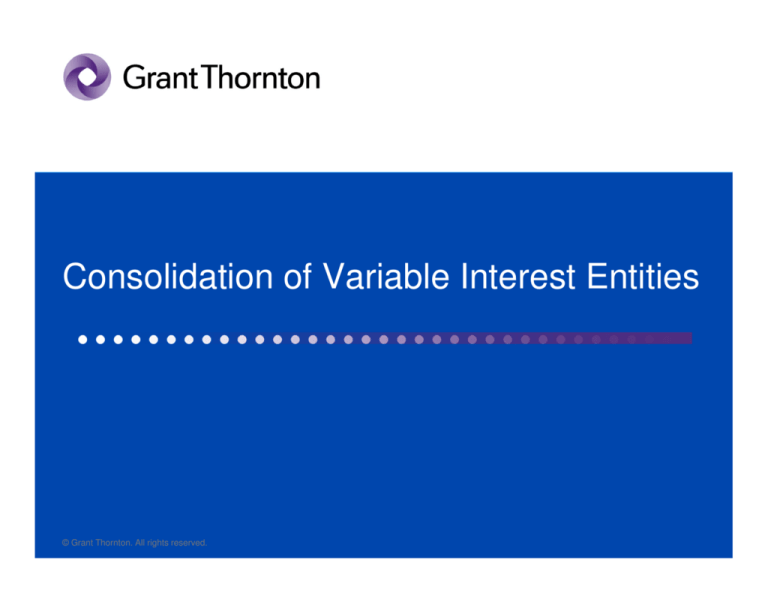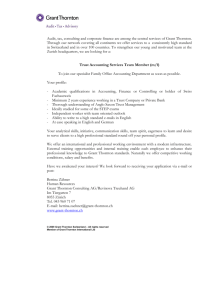
Consolidation of Variable Interest Entities
© Grant Thornton. All rights reserved.
Disclaimer
This Grant Thornton LLP presentation is not a comprehensive
analysis of the subject matters covered and may include
proposed guidance that is subject to change before it is
issued in final form. All relevant facts and circumstances,
including the pertinent authoritative literature, need to be
considered to arrive at conclusions that comply with matters
addressed in this presentation. The views and interpretations
expressed in the presentation are those of the presenters and
the presentation is not intended to provide accounting or other
advice or guidance with respect to the matters covered.
© Grant Thornton. All rights reserved.
2
Objectives
How the changes to the consolidation
requirements for variable interest entities were
affected:
• existing structures and future transactions
• your company's financial reporting and core
business
© Grant Thornton. All rights reserved.
3
Agenda
• Background
• Significant changes and examples
• Other discussion items
© Grant Thornton. All rights reserved.
4
Why was Statement 167 issued?
• Elimination of QSPE
• Structured Investment Vehicle (SIV’s)
and other entities
–that were off-balance sheet
–sponsor provided support to the entity
© Grant Thornton. All rights reserved.
5
Why was Statement 167 issued? (cont'd)
• Practice issues– quantitative risk and rewards test
• Improved Information to FS users
– Reconsideration events
– Disclosures
© Grant Thornton. All rights reserved.
6
Big picture
• Eliminates quantitative risks-and-rewards
approach to identifying primary beneficiary
(PB)
• Replaces w/ "qualitative" analysis of who has
both:
–Power AND
–Economic Interest
© Grant Thornton. All rights reserved.
7
Big picture (continued)
Power –
to direct activities which most
significantly impact the
economic performance of the
VIE
© Grant Thornton. All rights reserved.
8
Big picture (continued)
Economic Interestthe obligation to absorb losses
or receive benefits that could
potentially be significant to
the VIE
© Grant Thornton. All rights reserved.
9
Big picture (continued)
• Emphasizes: only substantive terms,
transactions, and arrangements to be
considered
• Significant management judgment
• considered & documented on
adoption
• on an ongoing basis
© Grant Thornton. All rights reserved.
10
Big picture, continued
• Reconsideration of previous conclusions
per FIN 46R :
– Is entity a VIE ?
– Service provider or decision maker fees
are VI's?
– Is enterprise the PB ?
– Disclosures required and how aggregated
?
© Grant Thornton. All rights reserved.
11
What has NOT changed under FAS 167
• Scope exceptions (other than for QSPEs)
• Conditions that identify an entity as a VIE
– Except -ASC 810-10-15-14(b) on the ability of
equity holders as a group to make decisions
• Definition of a variable interest
– Modification of whether fees paid to a decision
maker or service provider are variable interests
© Grant Thornton. All rights reserved.
12
What has not changed under FAS 167(continued)
• Concept of expected losses and expected residual
returns (expected variability)
– still relevant for VIE determination
– but NOT for PB identification
• Guidance on implicit variable interests from FSP
FIN 46(R) – 5
• Guidance on evaluating the design of an entity
from FSP FIN 46(R) – 6
© Grant Thornton. All rights reserved.
13
Guidance issued to date
• FASB Statement 167: Amendments to FASB
Interpretation No. 46(R)
– Issued in June 2009
• Codified by Accounting Standards Update 2009-17
– December 2009
– Included in ASC 810: Consolidations
• Amended by ASU 2010-10: Amendments for
Certain Investment Funds, in February 2010
© Grant Thornton. All rights reserved.
14
Agenda
• Background
• Significant changes and examples
• Implementing the new standard
• Other discussion items
© Grant Thornton. All rights reserved.
15
Scope
Partial deferral now in place
• ASU 2010-10 deferred effective date for certain
asset manager funds for either :
• an investment company (ASC 946-10-15-2)
or
• entity for which it is acceptable based on
industry practice to apply measurement
principles that are consistent with those of an
investment company (mortgage real estate
investment fund)
• SEE guidance for conditions
© Grant Thornton. All rights reserved.
16
Scope
QSPEs
FIN 46R
Observations and Implications
(paragraph 4c and 4d /
ASC 810-10-15-14)
Qualifying Special Purpose
Entity (QSPE) not subject to
consolidation
FAS 167
The scope exceptions
have been eliminated
• FAS 166 eliminated QSPE
concept
• Servicer of loans should
evaluate if service contract
gives it “power”
• Financial institutions have
phased implementation/
other regulatory capital
changes (see link below)
http://fdic.gov/news/news/press/2010/pr10216.html
© Grant Thornton. All rights reserved.
17
Scope
Reasonableness exception
FIN 46R(paragraph 6)
Reporting enterprise not required to determine whether an
entity is a VIE if:
• Apparent that potential VI would not be a significant VI in
the entity
• Reporting enterprise, its related parties, and its de facto
agents did not participate significantly in the design or
redesign of the entity
FAS 167
This exception has been deleted
© Grant Thornton. All rights reserved.
18
Consolidation of variable interest entities
Economic substance
• Consider only substantive terms, transactions,
and arrangements
• ? Is a reporting entity’s stated power to direct the
most significant activities disproportionately < its
economic interest in the entity? If so:
− Increase level of skepticism about the
enterprise’s apparent lack of power.
− Is economic interest in an entity indicative of the
amount of power the enterprise holds ?
© Grant Thornton. All rights reserved.
19
Consolidation of variable interest entities
Economic substance - SEC staff views
• Structures designed for an accounting or
financial reporting result
• Inconsistencies of structure with economic
substance of an arrangement
• Reduced transparency of financial reporting
• Recent proposed structures:
• At least the appearance of shared power
• With most of downside risk w/ sponsoring entity
© Grant Thornton. All rights reserved.
20
Consolidation of variable interest entities
Economic substance - SEC staff views (continued)
• Structures designed to deconsolidate
underperforming assets:
− Reporting entity appears to have
relinquished control
− Perhaps creating the appearance of shared
power ?
− In substance retains substantially all of the
economic risks of ownership ?
© Grant Thornton. All rights reserved.
21
Fees paid to decision makers or service providers
FIN 46R
Fees paid to a decision maker or a
service provider are not VIs if :
•Include substantive kick-out rights
(for decision maker fees) OR
customary cancellation provisions
(for service provider fees).
Observations and Implications
• Reassess previously
existing fee
arrangements
• Consolidation?
• Disclosure?
FAS 167
The conditions considered in VI
analysis of fees paid to a decision
maker or service provider have
been consolidated and modified:
• Cannot consider kick-out
rights or customary
cancellation provisions.
© Grant Thornton. All rights reserved.
• What "power" does the
fee arrangement provide
to the decision
maker/service provider ?
22
Are fees paid variable interests?
Fees paid are considered variable interests
unless all of the following 6 conditions are met:
1. Fees commensurate with level of effort required
to provide similar services
2. Fee is at or above the same level of seniority as
entity’s other operating liabilities, such as trade
payables.
3. Decision maker or service provider would not
absorb more than an insignificant amount of
expected losses or residual returns.
© Grant Thornton. All rights reserved.
23
Are fees paid to decision makers or service providers
variable interests?
Fees paid are considered variable interests
unless all of the following 6 conditions are met:
4. The service arrangement’s terms, conditions, or
amounts are customary
5. The anticipated fees are insignificant relative to
the VIE’s anticipated economic performance.
6. The anticipated fees are expected to absorb an
insignificant amount of the variability
© Grant Thornton. All rights reserved.
24
What is a Variable Interest Entity?
ASC 810-10-15-14
Legal entity
• With any of the following three conditions:
1) Insufficient Equity investment at risk
•
2) Substantially all activities involve or are
conducted on behalf of a single investor
with disproportionately few voting rights
© Grant Thornton. All rights reserved.
25
What is a Variable Interest Entity?
ASC 810-10-15-14 (continued)
3) As a group the holders lack any one of the
following characteristics:
• power to direct activities that most
significantly impact entity’s economic
performance
• obligation to absorb expected losses of the
entity
• the right to receive the expected residual
returns of the entity
© Grant Thornton. All rights reserved.
26
Revised definition of a VIE
FIN 46R
(paragraphs B18-21 / ASC 810-1055-33 thru 36)
Substantive kick-out rights
considered in determining whether
fees paid to a decision maker are a
variable interest
FAS 167
•Kick-out and participating
rights are ignored in
determining whether a VIE
• Unless those rights are held
by single party.
•Eliminates specific guidance
on whether such a right is
substantive.
© Grant Thornton. All rights reserved.
Observations and Implications
• Many limited
partnerships will now
meet the definition of
a variable interest
entity
27
Determining the primary beneficiary- Overview
FIN 46R
Observations and Implications
• FIN 46R and FAS 167- PB must
hold a variable interest
• May be required to provide
disclosures about its involvement
with the VIE
• Appendix C of FAS 167 provides
FAS 167
nine examples -analysis required
The PB is the enterprise that has
to identify the PB of a VIE.
both:
• securitizations and other
(1) Power - The power to direct
asset-backed financing
activities that most significantly
arrangements
impact the economic
performance of the VIE
• a property leasing entity
(2) Economics - the obligation to
• commercial operating
absorb losses or receive benefits
entities.
that could potentially be
significant
to the VIE
© Grant Thornton.
All rights reserved.
28
PB= Absorbs majority of
VIE’s expected losses and/or
receives majority of VIE’s
expected residual returns.
Determining the PB
Economic Interest
The obligation to absorb losses or receive
benefits that could potentially be significant to VIE
• Could potentially be significant
– Need to consider various scenarios
• Not the same as expected losses and expected
residual returns, as defined in FIN 46R
– Lower threshold than the previous requirement
– Prior based on majority of VIE’s expected losses and/or
expected residual returns
© Grant Thornton. All rights reserved.
29
Determining the PB
Economic Interest (continued)
• Generally, if an entity has power, it will have
economics
• More than one party involved with a VIE may meet
the economic criterion
– but only one enterprise, if any, is expected to
meet the power criterion
© Grant Thornton. All rights reserved.
30
Determining the PBSEC Views – Assessing potential economic significance
FAS 167
SEC staff views
No bright-line test for potential
Obligation to absorb losses significance
• Requires judgment
or receive benefits that
• Quantitative and qualitative
could potentially be
• Qualitative factors include, but
significant to the VIE
are not limited to:
• Purpose and design
• Terms and characteristics of
the financial interests
• Reporting enterprise’s
business purpose for holding
financial interest
Economic Interest
© Grant Thornton. All rights reserved.
31
Determining the PB
Power
The power to direct activities that most
significantly impact the economic performance of
the VIE
• Assess:
– Enterprise’s variable interests
– Related parties' variable interests
– De facto agents' variable interests
• Both implicit & explicit interests considered
© Grant Thornton. All rights reserved.
32
Determining the PB
Power
(continued)
The power to direct activities that most significantly
impact the economic performance of the VIE
• What is VIE’s purpose and design
• What are the risks the VIE was
designed to create and pass through to
its variable interest holders
(FSP FIN 46(R)-6/ ASC Section 810-10-25 and
810-10-55)
© Grant Thornton. All rights reserved.
33
Determining the PB
Power (continued)
The power to direct activities that most significantly
impact the economic performance of the VIE
• Identify activities that most significantly
affect the VIE’s economic performance
• Kick-out rights and participation rights are
not considered in PB determinations
– unless exercisable by a single party (or a
single related-party group).
© Grant Thornton. All rights reserved.
34
Determining the PB
Power (continued)
The power to direct activities that most significantly
impact the economic performance of the VIE
• Does enterprise’s significant involvement in the
design :
– Provide opportunity to establish arrangements
resulting in "power" ? Or NO power?
– Direct the entity’s most significant activities ?
– Note: Should not view these in isolation
• Level of economic interest indicative of amount of
power?
© Grant Thornton. All rights reserved.
35
Determining the PB
Power (continued)
The power to direct activities that most significantly
impact the economic performance of the VIE
• Is stated power to direct the entity’s most
significant activities disproportionately less
than its economic interest in the entity?
• Do not have to exercise its power to have
power to direct the activities of an entity
– (A38 of Basis for Conclusions)
© Grant Thornton. All rights reserved.
36
Determining the PB
Shared Power
• If power is shared, there is NO primary
beneficiary.
– 2 or more unrelated parties together sharing
power
– Power to direct the activities that most
significantly impact economic performance
– Decisions require consent of each party
© Grant Thornton. All rights reserved.
37
Determining the PB
Shared Power (continued)
• If power is not shared, the nature of the
activities each party is directing should
be considered
– Who's power most significantly impacts
the VIE’s economic performance ?
© Grant Thornton. All rights reserved.
38
Determining the PB
EXAMPLE
Facts
• VIE owned by 2 unrelated parties, Company A and
Company B
• Activities of VIE that most significantly impact
performance:
• manufacturing, distributing and selling of a
beverage
• Company A and B are both responsible for
manufacturing activities
• Company B is also responsible for distribution and
selling activities
© Grant Thornton. All rights reserved.
39
Determining the PB
EXAMPLE (continued)
Analysis
When would power be shared?
• All decisions about the
manufacturing, distribution, and
selling activities require the
consent of both companies
© Grant Thornton. All rights reserved.
40
Determining the PB
EXAMPLE (continued)
Analysis
When would power not be shared (mutual
consent not required over any activities)?
• If the manufacturing activities are not the
most significant Company B would
consolidate
• If the selling and distribution activities are
not significant need to evaluate who has
the power over the majority of the
manufacturing activities
© Grant Thornton. All rights reserved.
41
Determining the PB
SEC Views - Most significant activities and kick-out
rights
FAS 167
Significant Activities
Kick-out and participation
rights not considered in
primary beneficiary
determination, unless
exercisable by a single
party
Shared power
© Grant Thornton. All rights reserved.
SEC staff views
Skeptical about the existence
of any entities with no
significant activities
An entity’s board of directors
generally cannot be treated as
a single party
Approach assertions that
power is shared with a healthy
dose of skepticism.
42
Related party group
FIN 46R
Party within the group that is most closely
associated with the VIE is the PB.
FAS 167
If neither related party has both characteristics
of PB, but as a group does, then the party within
the group that is most closely associated with
the VIE is the PB .
© Grant Thornton. All rights reserved.
43
Reconsideration of PB determination
•Reconsideration only when specified events occur.
•A troubled debt restructuring is not a reconsideration
event.
FAS 167
• Reconsideration on ongoing basis and is not
limited to specified events.
• Consider loss of power to direct the entity’s most
significant activities
•A troubled debt restructuring is no longer exempt
from reconsideration.
© Grant Thornton. All rights reserved.
44
PB ReconsiderationObservations and Implications
• Reevaluate each reporting period
• Must Consolidate VIE as of date it becomes PB,
which may not be as of the beginning or end of a
reporting period.
• May result in volatility between reporting periods
due to ongoing reassessments
• Will require changes to processes, information
systems, internal controls, and data requirements
• Will require management to obtain more timely
information from the VIE
© Grant Thornton. All rights reserved.
45
Presentation and disclosure
• Disclosures apply to both public and non public
enterprises
• FAS 167 eliminates “significance” threshold for non
PB disclosures
• Must consider disclosure objectives and need to
supplement the required disclosures
• Disclosures are significant and may require
management to obtain additional information from
the variable interest entity
© Grant Thornton. All rights reserved.
46
Presentation and disclosure (continued)
• Requires separate balance sheet presentation of
consolidated VIE:
– Assets that can only be used to settle
obligations of the VIE
– Liabilities for which the creditors or beneficial
interest holders lack recourse to the general
credit of the primary beneficiary
• How consolidation decision was made
(assumptions, process, expectations)
© Grant Thornton. All rights reserved.
47
Effective date
• All existing entities must be reevaluated on
effective date
• Effective as of the beginning of the first
annual reporting period that begins after
November 15, 2009 (January 1, 2010 for
calendar year-end enterprises)
• Earlier application is prohibited
© Grant Thornton. All rights reserved.
48
Transition
• Assets, liabilities, and noncontrolling
interests of a VIE that is newly consolidated
should be measured at adoption-date
carrying amounts
– Determined as if FAS 167 had been in effect
when the reporting enterprise first met the PB
conditions
© Grant Thornton. All rights reserved.
49
Transition (continued)
• If impracticable to determine adoption-date
carrying amounts-required to either:
– Measure everything at adoption-date fair values
– Measure at unpaid balances and fair value items
that do not have unpaid balance or that are
otherwise required to be measured at fair value.
© Grant Thornton. All rights reserved.
50
Securitization Example
• Variable interest entity
•Established by transferor
•Issue beneficial interest in two tranches; 90% senior
interest and 10% junior interest
• Transferor (reporting entity)
•Transferred loans to VIE
•Obtains junior interest and primary servicing
responsibilities
•Servicing responsibilities are administrative in nature
© Grant Thornton. All rights reserved.
51
Securitization Example (continued)
Transferor (reporting entity) (continued)
•Earns a fixed fee determined as a percentage of
unpaid principal balance of loans
•Can be replaced by majority vote of the third-party
beneficial interest holders
© Grant Thornton. All rights reserved.
52
Securitization Example (continued)
Special servicer
•When loans become 90 days delinquent, servicing
responsibilities are transferred from transferor to
special servicer
•Earns a fixed fee, and a performance
• fee in which it receives a portion of the entity’s
profit above a targeted return
•Can be replaced by majority vote of the third-party
beneficial interest holders
© Grant Thornton. All rights reserved.
53
Securitization Example (continued)
Does the transferor have a variable interest
in the VIE?
• Yes, the transferor’s junior interest
represents a variable interest. In addition,
the transferor’s servicing arrangement
should be evaluated to determine if it results
in a variable interest.
© Grant Thornton. All rights reserved.
54
Securitization Example (continued)
What are the other variable interests in the
entity?
• Senior beneficial interests held by third
parties
• Special servicer arrangement (based on the
application of paragraph B22 of FIN 46R as
amended by FAS 167)
© Grant Thornton. All rights reserved.
55
Securitization Example (continued)
What activities most significantly
impact the VIEs economic
performance?
• Ability to mitigate losses on loans that
become delinquent
© Grant Thornton. All rights reserved.
56
Securitization Example (continued)
Which variable interest holder, if any,
has the power to direct the VIEs
most significant activities?
•The transferor through its servicing
arrangement?
•Administrative in nature
•Cannot be kicked out by a single party
© Grant Thornton. All rights reserved.
57
Securitization Example (continued)
Which variable interest holders meet
the economic criterion?
• Transferor through its ownership of the
junior interest which absorbs losses first
• Special servicer through its fee
arrangement
• Senior beneficial interest holders
potentially
© Grant Thornton. All rights reserved.
58
Securitization Example (continued)
Conclusion-The special servicer would
consolidate because
1) Has power to direct activities that are most
significant to the economic performance of
the VIE as it is responsible for mitigating
losses on loans that become delinquent
2) It has the right to receive benefits that could
potentially be significant as a result of its
performance fee arrangement
© Grant Thornton. All rights reserved.
59
Related Party Lease Example (continued)
Facts and Assumptions
•An individual owns a majority voting equity interest
in both a manufacturing entity and an entity
designed to hold only the property leased to the
manufacturing entity
•Property held by the lessor entity is subject to bank
financing that is personally guaranteed by the
majority owner
© Grant Thornton. All rights reserved.
60
Related Party Lease Example (continued)
Facts and Assumptions (continued):
– The lease is classified as an operating lease
– Has market terms
– Provides no explicit guarantees or purchase
options
– Contains no other terms or conditions that would
indicate that the lease itself represents an explicit
variable interest in the lessor entity
© Grant Thornton. All rights reserved.
61
Related Party Lease Example (continued)
Facts and Assumptions (continued):
•Is the only contractual relationship between
the two entities
• Lessor entity is a VIE
•Manufacturing entity has an implicit variable
interest in the lessor entity
© Grant Thornton. All rights reserved.
62
Related Party Lease Example (continued)
Does the manufacturing entity have a variable
interest in the lessor entity?
• Yes, because this example assumes the
existence of an implicit variable interest
resulting from the leasing arrangement and the
relationship between the manufacturing entity
and the owner of the lessor entity.
•FAS 167 does not change existing guidance
on identifying implicit variable interests.
© Grant Thornton. All rights reserved.
63
Related Party Lease Example (continued)
What are the other variable interests in the
lessor entity?
•Bank debt
•Guarantee of bank debt
•Equity interests
© Grant Thornton. All rights reserved.
64
Related Party Lease Example (continued)
What are the activities that most significantly
impact the economic performance of the lessor
entity?
•Maintenance and operation of the leased property
during both the explicit and implicit terms of the lease
•These activities impact the value of the market rents
that the lessor entity is able to obtain by leasing the
property and the amount the lessor entity could receive
from the sale of the property
© Grant Thornton. All rights reserved.
65
Related Party Lease Example (continued)
Does the manufacturing entity have the
power to direct the most significant
activities?
Yes, the manufacturing entity is
responsible for the maintenance and
operation of the leased property
© Grant Thornton. All rights reserved.
66
Related Party Lease Example (continued)
Does the manufacturing entity have an
obligation for losses or right to benefits
of the lessor entity that are potentially
significant to the lessor?
Yes
© Grant Thornton. All rights reserved.
67
Related Party Lease Example (continued)
Conclusion
The manufacturing entity meets both the power and
economic criteria that identify the primary beneficiary of
a VIE under FAS 167, therefore
• The manufacturing entity is the primary beneficiary
of the lessor entity
• The primary beneficiary determination in this
example is not based on determining which party in
a related party group is most closely associated with
the lessor entity
© Grant Thornton. All rights reserved.
68
Codification cheat sheet
ASC 810-10, Variable interest entities subsections
FIN 46R, as amended
by Statement 167
Codification
Terminology
Enterprise
Reporting entity
Terminology
Entity
Legal entity or Variable
Interest Entity (VIE)
Scope exceptions
Paragraph 4
Section 810-10-15
Determining if a legal entity is a
variable interest entity
Paragraph 5
Paragraph 810-10-15-14
Determining the primary beneficiary
Paragraph 14 – 14G
Paragraph 810-10-25-38
through 38G
Fees paid to a decision maker
Paragraphs B22-B23
Paragraph 810-10-55-37
through 55-38
Disclosures
Paragraph 22B-26
Section 810-10-50
Examples, implementation guidance,
and related FSP’s and EITF Issues
Appendix C
Section 810-10-55
© Grant Thornton. All rights reserved.
69
Questions?
© Grant Thornton. All rights reserved.
70
Diane J. Reich
101 E. Kennedy Blvd,
Suite 3850
Tampa, FL 33602
813-204-5187
© Grant Thornton. All rights reserved.
71








